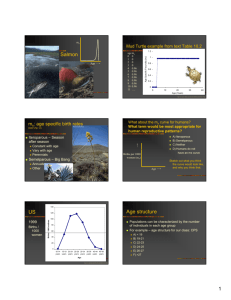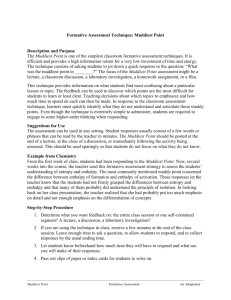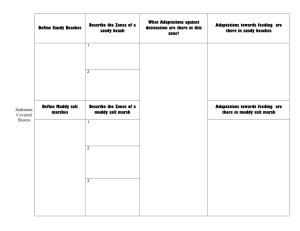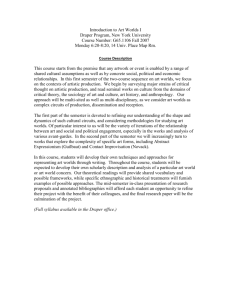A muddy children and intro to modal logic.
advertisement
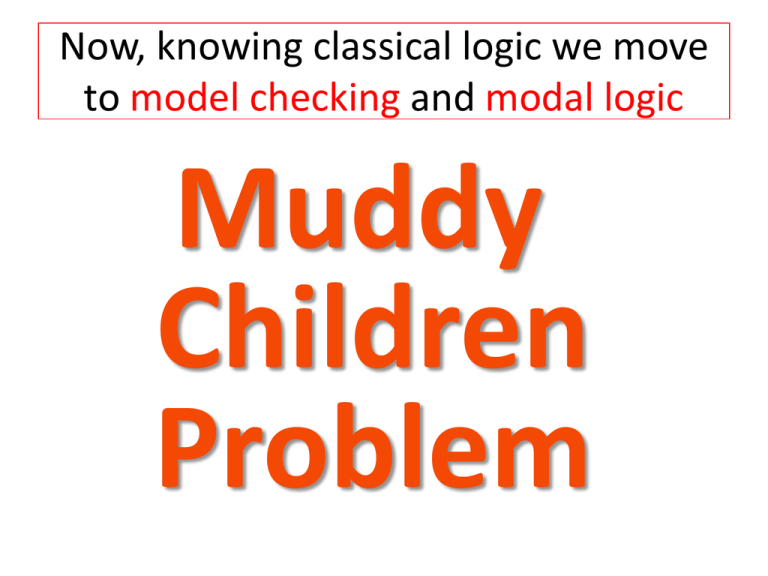
Now, knowing classical logic we move
to model checking and modal logic
Muddy
Children
Problem
The Muddy Children Puzzle
1. n children meet their father after playing in the mud. The
father notices that k of the children have mud dots on their
foreheads.
2. Each child sees everybody else’s foreheads, but not his own.
3. The father says: “At least one of you has mud on his
forehead.”
4. The father then says: “Do any of you know that you have
mud on your forehead? If you do, raise your hand now.”
5. No one raises his hand.
6. The father repeats the question, and again no one moves.
7. After exactly k repetitions, all children with muddy foreheads
raise their hands simultaneously.
Muddy Children, Dirty Kids, Wise men,
Cheating Husbands, etc.
Muddy Children (cont.)
• Suppose k = 1
• The muddy child knows the
others are clean
• When the father says at least
one is muddy, he concludes
that it’s him
Muddy Children.
Concluding – recursion starter
• BEST CASE: One child
Muddy Children (cont.)
• Suppose k = 2
• Suppose you are muddy
• After the first announcement, you see
another muddy child, so you think
perhaps he’s the only muddy one.
• But you note that this child did not raise
his hand, and you realise you are also
muddy.
• So you raise your hand in the next round,
and so does the other muddy child
Muddy Children.
• Detailed analysis of two children
CASE 1: 1 child has mud dot on his head
CASE 2: Both children have
mud dots on their heads
Muddy Children.
• Now suppose there are 3 children
Muddy Children.
• Case of three children
Muddy Children.
• Case of three children
Muddy Children.
• Case of three children
Muddy Children.
• Case of N children
1.
2.
3.
4.
5.
Assume N children
Assume K have mud on heads.
Assuming – common knowledge of at least one dot ,
all perfect reasoners
each round of reasoning takes one unit
Theorem
K children will speak at time t=K
The crucial concepts:
1. Common knkowledge
2. Consequential closure
This is the simplest
problem that can be
solved using modal logic
and its variants
The Partition
Model of
Knowledge
Concepts to remind from classical logic
1.
2.
3.
4.
5.
6.
7.
Agent
Group of agents
Language
Ordered tuple for definition
Possible worlds
Interpretation function
Partitions of set
Worlds and non-distinguishability of worlds
Example of worlds
•
•
Suppose there are two propositions p and q
There are 4 possible worlds:
–
–
–
–
•
•
w1: p q
w2: p q
w3: p q
w4: p q
W = {w1 , w2 , w3 , w4 } is the set of all worlds
Suppose the real world is w1, and that in w1 agent i
cannot distinguish between w1 and w2
We say that Ii(w1) = {w1, w2}
–
This means, in world w1 agent i cannot distinguish between
world w1 and world w2
Function I describes non-distinguishability of worlds
Partition Model of knowledge, partition of
worlds in the set of all worlds W
• What is partition of worlds?
– Each Ii is a partition of W for agent i
• Remember: a partition chops a set into disjoint sets
• Ii(w) includes all the worlds in the partition of world w
• Intuition:
– if the actual world is w, then Ii(w) is the set of
worlds that agent i cannot distinguish from w
– i.e. all worlds in Ii(w), all possible as far as i knows
W = set of all worlds for Muddy Children with
two children
• This is knowledge of child 2
w2
w1
w4
w3
Partition model when children see one another
but before father speaks
Now we can define the partition model of Knowledge
The Partition Model of Knowledge
• An n-agent partition model over language is
A = (W, , I1, …, In) where
– W is a set of possible worlds
– : 2W is an interpretation function that
determines which sentences are true in which
worlds
– Each Ii is a partition of W for agent i
• Remember: a partition chops a set into disjoint sets
• Ii(w) includes all the worlds in the partition of world w
The Knowledge
Operator
1. By Ki we will denote that:
“agent i knows that ”
It describes the knowledge of an agent
Logical Entailment
• What is logical entailment?
• Let us recall definition:
– We say A,w |= Ki if and only ifw’,
if w’Ii(w), then A,w |=
• Intuition: in partition model A, if the actual
world is w, agent i knows if and only if is
true in all worlds he cannot distinguish from w
The Knowledge Operator
1. By Ki we will denote that:
“agent i knows that ”
2. Let A = (W, , I1, …, In) be a partition model over
language and let w W
: 2W is an interpretation function
3. We define logical entailment |= as follows:
1. For we say (A,w |= ) if and only if w ()
2. We say A,w |= Ki if and only ifw’,
if w’Ii(w), then A,w |=
Example of Knowledge Operator for Muddy Children
Partitioning all possible worlds for agents in case of Two
Muddy Children
Note: in w1 we have:
K1 muddy2
K2 muddy1
K1 K2 muddy2
…
But we don’t have:
K1 muddy1
Partition for agent 2 (what
child 2 knows)
Child 1 but not child 2
knows that child 2 is
muddy
Partition for agent 1
Knowledge
operators
Bold oval = actual world
Solid boxes = equivalence classes in I1
Dotted boxes = equivalence classes in I2
1.
2.
3.
4.
w1: muddy1 muddy2 (actual
world)
w2: muddy1 muddy2
w3: muddy1 muddy2
w4: muddy1 muddy2
Muddy
Children
Revisited
Now we have all background to illustrate solution to
Muddy Children
Muddy Children Revisited
1. n children meet their father after playing in
the mud.
2. The father notices that k of the children have
mud on their foreheads.
3. Each child sees everybody else’s foreheads,
but not his own.
Muddy Children Revisited (cont.).
The Case of two muddy children
Formulation of logic variables and possible worlds
1.
Suppose n = k = 2 (two children, both muddy)
2.
3.
4.
As the first step we have to formalize the worlds.
To formalize worlds, we need logic variables
Logic variables are muddy1 for child 1 being muddy, muddy2 for child 2 being
muddy, etc.
5.
With this all Possible Worlds w are the following:
1.
2.
3.
4.
w1: muddy1 muddy2 (actual world)
w2: muddy1 muddy2
w3: muddy1 muddy2
w4: muddy1 muddy2
6.
These are all combinations of values of variables muddy1 muddy2 , no more are
possible
7.
At the start, no one sees or hears anything, so all worlds are possible for each child
8.
After seeing each other, each child can tell apart worlds in which the other child’s
state is different
Partitioning all possible worlds for agents in case of
Two Muddy Children
Note: in w1 we have:
K1 muddy2
K2 muddy1
K1 K2 muddy2
…
But we don’t have:
K1 muddy1
Partition for agent 2 (what
child 2 knows)
Child 1 but not child 2
knows that child 2 is
muddy
Partition for agent 1
Bold oval = actual world
Solid boxes = equivalence classes in I1
Dotted boxes = equivalence classes in I2
1.
2.
3.
4.
w1: muddy1 muddy2 (actual
world)
w2: muddy1 muddy2
w3: muddy1 muddy2
w4: muddy1 muddy2
Now we will consider stages of Muddy
Children after each statement from father
Modification to knowledge and partitions done by
the announcement of the father
• The father says: “At least one of you has mud
on his forehead.”
– This eliminates the world:
w4: muddy1 muddy2
1.
2.
3.
4.
w1: muddy1 muddy2 (actual
world)
w2: muddy1 muddy2
w3: muddy1 muddy2
w4: muddy1 muddy2
Muddy Children Revisited (cont.)
Now, after father’s
announcement, the children
have only three options:
1. Other child is muddy
2. I am muddy
3. We are both muddy
For instance in I2 we see that
child 2 thinks as follows:
1. Either we are both muddy
2. Or he (child1) is muddy and
I (child 2) am not muddy
1. The same for Child 1
2. So each partition has more
than one world and none of
children can communicate
any decision
Bold oval = actual world
Solid boxes = equivalence classes in I1
Dotted boxes = equivalence classes in I2
1.
2.
3.
4.
w1: muddy1 muddy2 (actual world)
w2: muddy1 muddy2
w3: muddy1 muddy2
w4: muddy1 muddy2
Muddy Children Revisited (cont.)
Modification to knowledge and partitions done by
the SECOND announcement of the father
• The father then says: “Do any of you know
that you have mud on your forehead? If you
do, raise your hand now.”
– Here, no child raises his hand.
– But by observing that the other child did not raise
his hand (i.e. does not know whether he’s
muddy), each child concludes the true world
state.
– So, at the second announcement from father,
they both raise their hands.
Muddy Children Revisited (cont.)
Note: in w1 we have:
K1 muddy1
K2 muddy2
K1 K2 muddy2
…
1. Child 1 knows he is
muddy
2. Child 2 knows he is
muddy
3. Both children know they
are muddy
Bold oval = actual world
Solid boxes = equivalence classes in I1
Dotted boxes = equivalence classes in I2
1.
2.
3.
4.
w1: muddy1 muddy2 (actual
world)
w2: muddy1 muddy2
w3: muddy1 muddy2
w4: muddy1 muddy2
“Non-Modal” Muddy Children
Homework
1.
2.
3.
4.
The problem is like Muddy Children with three children but the children can give
non-unique answers, like k or k+1 children are muddy.
But this is only when not enough information immediately available.
We have to introduce time. When the output stabilizes, the information given by
the output is correct.
The role of delays in logic gates here is important, serves as a modality.
Design a combinational logic circuit
Child 1 is muddy
1.
2.
3.
It must be a
combinational logic
circuit
No memory
No MV logic
Child 1
muddy
Child 2
muddy
Child 3
muddy
Child 1
answers
Child 2 is muddy
Child 3 is muddy
Child 2
answers
Child 3
answers
Various versions
possible
Muddy 1
Child 1 shouts
“I am muddy”
Muddy 2
Child 2 shouts
“I am muddy”
Muddy 3
Child 3 shouts
“I am muddy”
1
exor
Child 1 shouts
“I am muddy”
exor
Child 2 shouts
“I am muddy”
exor
Child 3 shouts
“I am muddy”
No Child
shouted
No Child
shouted
3
2
Homework 1: Complete this diagram for Muddy Children
Homework 2: Draw State Machine Diagram for a Model
for Muddy Children
Muddy Children
Revisited
Again
with 3 children
Reminder of formulation for 3 children
General claim for n, k
Induction
We want to build our intuition about
creating models
How to formulate inductive hypothesis
In our model, we will not only draw states of logic variables in each world,
but also some relations between the worlds, as related to knowledge of each agent
(child). These are non-distinguishability relations for each agent A, B, C
Back to initial example: n = 3, k = 2
• An arrow labeled A (B, C resp.) linking two states indicates that A (B, C
resp.) cannot distinguish between the states (reflexive arrows indicate
that every agent considers the actual state possible).
• Initial situation:
State of C
State of A
State of B
This is a situation before
any announcement of
father
An arrow labeled A
linking two states
indicates that A cannot
distinguish between
the states
Note that at every state, each agent cannot distinguish between two states
New information (father talks) removes some worlds
with their labels on arrows
This is a situation after
first announcement of
father
ccc eliminated
Green color means that
the agent is certain
States mmc, ccm and cmc are
removed from set of worlds
Reduction of the set of worlds
This is a situation after
second announcement
of father
Reduction of the set of worlds
This is a situation after
second announcement
of father
• After third announcement of father, states mmc ,
cmm and mcm are eliminated and only state mmm
becomes possible
Final Reduction of the set of worlds after third
announcement of father
This is a situation after
third announcement of
father
only state mmm
becomes possible
Where we are?
1. We were using models, as they are used in modal
logic
2. One method used partitions, other method used
relations of non-distinquishability
–
The deep concept is the same
3. But we did not know what is the name of the
formalism that we used.
4. Now we will introduce modal logic formally as we
have a good intuition about logic variables in
different worlds.
5. We understand also agents and their knowledge.
Models and model checking is the
fundament of modal and similar logics
Where we are?
Homework 3.
1. Using Karnaugh Maps, solve the Muddy Children
problem removing step by step the cells of the
map that cannot be a solution.
2. How do you know how to go from step to next
step?
3. What knowledge can be used?
4. Can you modify your circuits from Homework 1
and Homework 2?
Modal
Logic
Modal Logic: basic operators
1. Can be built on top of any language
2. Has several special variants related to sub-domains
3. Two modal operators:
–
–
reads “ is necessarily true”
reads “ is possibly true”
4. Equivalence:
–
–
5. So we can use only one of the two operators, for instance
“necessary”
6. But it is more convenient to use two operators.
7. Next we will be using even more than two, but the
understanding of these two is crucial.
Modal Logic: Syntax
• Let P be a set of propositional symbols
• We define modal language L as follows:
• If p P and , L then:
–
–
–
–
pL
L
L
L
• Remember that , and ( ) and
• We can extend the language defining new symbols of
operators
Modal Logic: Semantics
• Semantics is given in terms of Kripke
Structures (also known as possible
worlds structures)
• Due to American logician Saul Kripke,
City University of NY
• A Kripke Structure is (W, R)
– W is a set of possible worlds
– R : W W is an binary accessibility
relation over W
– This relation tells us how worlds are
accessed from other worlds
Saul Kripke
He was called “the
greatest philosopher of
the 20st century
1. We already introduced two close to one another
ways of representing such set of possible worlds.
2. There will be many more.
Meaning of Entailment
Entailment says what we
can deduce about state of
world, what is true in
them.
Part of the Definition of entailment relation :
1. M,w |= if is true in w
2. M,w |= if M,w |= and M,w |=
Given
Kripke
model
with
state w
state w
formula
If there are two formulas that are
true in some world w than a logic
AND of these formulas is also true
in this world.
Semantics of Modal Logic: Definition of Entailment
Definition of Kripke Model
Kripke
Structure
A world
• A Kripke model is a pair M,w where
– M = (W, R) is a Kripke structure and
– w W is a world
Definition of Entailment Relation in Kripke Model
• The entailment relation is defined as follows:
1.
2.
3.
4.
M,w |= if is true in w
M,w |= if M,w |= and M,w |=
M,w |= if and only if we do not have M,w |=
M,w |= if and only if w’ W such that
R(w,w’) we have M,w’ |=
It is true in every word that
is accessible from world w
accessibility relation over W
Satisfiable formulas in Kripke models
for modal logic
1. In classical logic we have the concept of valid
formulas and satisfiable formulas.
2. In modal logic it is as in classical logic:
–
–
Any formula is valid (written |= ) if and only if
is true in all Kripke models
E.g. is valid
Any formula is satisfiable if and only if is true in
some Kripke models
3. We write M, |= if is true in all worlds of M
All Kripke models or all worlds from Kripke Model???
Relation to classical satisfiability and entailment
1. For a particular set of propositional constants P, a Kripke model is a threetuple <W,R, V> .
2. W is the set of worlds.
3. R is a subset of W × W, which defines a directed graph over W.
4. V maps each propositional constant to the set of worlds in which it is true.
5. Conceptually, a Kripke model is a directed graph where each node is a
propositional model.
6. Given a Kripke model M = <W,R, V> , each world w W corresponds to a
propositional model: it says which propositions are true in that world. In each
such world, satisfaction for propositional logic is defined as usual.
7. Satisfaction is also defined at each world for <> , and this is where R is
important.
8. A sentence is possibly true at a particular world whenever the sentence is
true in one of the worlds adjacent to that world in the graph defined by R.
Relation to classical satisfiability and entailment
1. Satisfiability can also be defined without reference
to a particular world and is often called global
satisfiability.
2. A sentence is globally satisfied by model M =
<W,R, V> exactly when for every world w W it is
the case that |=M,w .
3. Entailment in modal logic is defined as usual:
–
“ the premises logically entail the conclusion
whenever every Kripke model that satisfies also
satisfies .”
Please observe that I talk about every Kripke model and not every
world of one Kripke Model
Modal Logic: Semantics concepts
Intuitions for classical logic:
1.
2.
3.
4.
5.
6.
7.
World = cell of Kmap.
Valid = Kmap of all symbols “1” (ones).
Satisfiable = Kmap with at least one symbol “1”.
Non-satisfiable = Kmap with all zeros.
Contingent = Kmap with some ones some zeros.
Necessary = Kmap with all ones.
False = Kmap with all zeros.
Intuitions for Kripke Model:
1.
2.
3.
4.
5.
6.
7.
World = cell of Kmaps accessible by some accessability relation.
Valid = Kmap of all symbols “1” (ones) in accessible cells.
Satisfiable = Kmap with at least one symbol “1”, in accessible cells.
Non-satisfiable = Kmap with all zeros in accessible cells..
Contingent = Kmap with all zeros in accessible cells..
Necessary = Kmap with all ones in accessible cells..
False = Kmap with all zeros in accessible cells..
Modal Logic: Axiomatics
• Is there a set of minimal axioms that allows us
to derive precisely all the valid sentences?
• Some well-known axioms:
1. Axiom(Classical) All propositional tautologies
are valid
2. Axiom (K) ( ( )) is valid
3. Rule (Modus Ponens) if and are valid,
infer that is valid
4. Rule (Necessitation) if is valid, infer that is
valid
These are enough, but many other
can be added for convenience
Sound and complete sets of inference
rules in Modal Logic Axiomatics
• Refresher:
remember that
1. A set of inference rules (i.e. an inference procedure)
is sound if everything it concludes is true
2. A set of inference rules (i.e. an inference procedure)
is complete if it can find all true sentences
• Theorem:
System K is sound and complete for the class of all
Kripke models.
What is system K?
Multiple Modal Operators
• We can define a modal logic with n modal
operators 1, …, n as follows:
1. We would have a single set of worlds W
2. n accessibility relations R1, …, Rn
3. Semantics of each i is defined in terms of Ri
Powerful concept – many
accessibility relations
Axiomatic theory
of the partition
model
Axiomatic theory of the partition model
• Objective: Come up with a sound and
complete axiom system for the partition
model of knowledge.
• Note: This corresponds to a more restricted
set of models than the set of all Kripke
models.
• In other words, we will need more axioms.
Axiomatic theory of the partition model
Ki means “agent i knows that”
1. The modal operator i becomes Ki
2. Worlds accessible from w according to Ri are those
indistinguishable to agent i from world w
3. Ki means “agent i knows that”
4. Start with the simple axioms:
1. (Classical) All propositional tautologies are valid
2. (Modus Ponens) if and are valid, infer that is
valid
Now we are defining a logic of knowledge
on top of standard modal logic.
Axiomatic theory of the partition model
(More Axioms)
• (K) From (Ki Ki( )) infer Ki
– Means that the agent knows all the consequences
of his knowledge
– This is also known as logical omniscience
• (Necessitation) From , infer that Ki
– Means that the agent knows all propositional
tautologies
In a sense, these agents are inhuman, they are more like
God, which started this whole area of research
Remember,
we introduced
the rule K
This defines
some logic
Axiomatic theory of the partition model (More
Axioms)
• Axiom (D) Ki ( )
– This is called the axiom of consistency
• Axiom (T) (Ki )
– This is called the veridity axiom
– Means that if an agent knows something than is
true.
– Corresponds to assuming that accessability
relation Ri is reflexive
Axiom D means that nobody can
know nonsense, inconsistency
Remember symbols D and T of
axioms, each of them will be used to
create some type of logic
Refresher: what is Euclidean
relation?
• Binary relation R over domain Y is Euclidian
– if and only if
– y, y’, y’’ Y, if (y,y’) R and (y,y’’) R then (y’,y’’) R
• (y,y’) R and (y,y’’) R then (y’,y’’) R
R
y
R
y’
R
y
R
y’’
y’
R
y’’
Axiomatic theory of the partition model (More
Axioms)
• Axiom (4) Ki Ki Ki
– Called the positive introspection axiom
– Corresponds to assuming that Ri is transitive
• Axiom (5) Ki Ki Ki
– Called the negative introspection axiom
– Corresponds to assuming that Ri is Euclidian
Remember symbols 4 and 5 of
axioms, each of them will be used to
create some type of logic
Axiomatic theory of the partition model (Overview of
Axioms)
Table. Axioms and corresponding constraints on the accessibility relation.
1.
2.
Proposition: a binary relation is an equivalence relation if and only if it is reflexive,
transitive and Euclidean
Proposition: a binary relation is an equivalence relation if and only if it is reflexive,
transitive and symmetric
Some modal logic systems take only a subset of this set. All general , problem independent
theorems can be derived from only these axioms and some additional, problem specific axioms
describing the given puzzle, game or research problem.
What to do with these axioms?
Now that we have these axioms, we can
take some of their sets , add them to
classical logic axioms and create new
modal logics.
The most used is system K45
Homework 4.
Try to derive some new theorems from the
axioms above. Is any of these theorems useful?
Is any of these theorems counter-intuitive?
Axiomatic theory of the partition model (back to
the partition model)
1. System KT45 exactly captures the properties
of knowledge defined in the partition model
2. System KT45 is also known as system S5
3. S5 is sound and complete for the class of all
partition models
And now a test…
• Next slide has a problem formulation of a relatively not
difficult but not trivial problem in modal logic.
• Please try to solve it by yourself, not looking to my
solution.
• If you want, you can look to internet for examples of
theorems in modal logic that you can use in addition to
those that are in my slides. I do not know if this would
help to find a better solution but I would be interested
in all what you get.
• Good luck. You can use system BK, or any other system
of modal logic from these slides.
Example of proving in
Modal Logic
1. Given is system BK of modal logic with all its axioms,
theorems, and proof methods
2. Given are two axioms:
• A axiom
• L axiom
A Axiom: Ge Necessarily (Ge)
L Axiom: Possible (Ge)
3. Prove that Ge
Ge
Do not look to the next slide with the
solution!!!
X Necessarily(X)
1
A Axiom: Ge Necessarily (G)
Modal Logic thesis:
Necessarily(p q)
(Possible(p) Possible(q)),
X = Ge Necessarily (Ge)
Necessarily (Ge Necessarily(Ge) )
q= Necessarily(Ge)
p=Ge
2
Possible(Ge) Possible (Necessarily(Ge))
Thesis specific to BK system of modal logic:
Possible( Necessarily (p) ) p
3
p = Ge
Possible( Necessarily (Ge) ) Ge
4
Possible(Ge) Ge
L Axiom: Possible (Ge)
5
Here is the solution.
Do you know that you proved that
God exists?
This is a famous proof of Hartshorne,
which resurrected interest among
analytic philosophers in proofs of
God’s Existence. See next slide.
Ge
System BK of modal logic is used
Ge or “God Exists”?
• Amazingly, when I showed the proof from last
slide to some people, they told me “OK”.
• When I showed them the next slide, and I
claimed that the proof proves God’s existence,
they protested.
Can you explain me why?
X Necessarily(X)
1
Anselm Axiom: God_exists
AA
Necessarily (God_exists)
X = God_exists Necessarily (God_exists)
Necessarily (God_exists Necessarily(God_exists) )
Modal Logic thesis:
Necessarily(p q)
(Possible(p) Possible(q)),
q= Necessarily(God_exists)
p=God_exists
2
Possible(God_exists) Possible (Necessarily(God_exists))
Thesis specific to BK system of modal logic:
Possible( Necessarily (p) ) p
3
p = God_exists
Possible( Necessarily (God_exists) ) God_exists
4
Possible(God_exists) God_exists
5
This is the same proof, the same
axioms. We only give the historical
assumptions. Axiom A is from Saint
Anselm – it is like if Pythagoras invents
his theorem in his head – then the
theorem is true in any World. Axiom L
comes from Leibniz – “we can create a
consistent model of God in our head”.
Leibnitz Axiom: Possible (God_Exists)
God _exists
Can we invent a puzzle
like Muddy Children with
these axioms?
System BK of modal logic is used
We are back to Muddy Children…
1. We will formulate now a completely formal
modal (knowledge) logic, language based
formulation of Muddy Children
2. Before you read, try to do this by yourself.
3. Invent another puzzle similar to Muddy
Children and formulate it in Modal Logic.
Muddy Children – Formulation in Logic
Muddy Children – Formulation in Logic (cont)
The children are now so smart that we call them wise men
and not children any more.
Muddy Children – Inference in Logic
Lemma 1.A
Lemma 1.B
Lemma 1.C
Muddy Children – Inference in Logic
Lemma 2.A:
.. And so on….
Solving problems is
like proving theorem
in modal logic
We will give more examples to
motivate you to modal logic using
puzzles and games
More examples to motivate
thinking about models and
modal logic.



